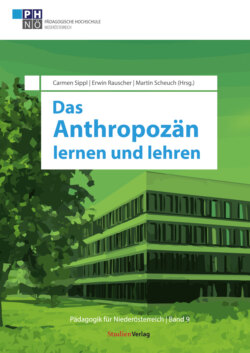Читать книгу Das Anthropozän lernen und lehren - Группа авторов - Страница 32
Literatur
ОглавлениеAllenby, Brad & Mikhail Chester 2018. Reconceptualizing Infrastructure in the Anthropocene. Issues in Science and Technology 34(3).
AMAP 2012. Arctic Climate Issues 2011: Changes in Arctic Snow, Water, Ice and Permafrost.
SWIPA 2011 Overview Report. Oslo: Arctic Monitoring and Assessment Programme.
Bartsch, Annett & Alexandra Meyer 2017. „Klimawandel in der Arktis: Perspektiven aus den Natur- und Sozialwissenschaften“, in Gertrude Saxinger, Peter Schweitzer & Stefan Donecker (Hg.): Arktis und Subarktis: Geschichte, Kultur und Gesellschaft. Wien: New Academic Press, 166–183.
Chua, Liana & Hannah Fair 2019. „Anthropocene”, in Felix Stein, Andrew Sanchez, Hildegard Diemberger, Sian Lazar, Joel Robbins, Matei Candea & Rupert Stasch (eds.): The Cambridge Encyclopedia of Anthropology. https://www.anthroencyclopedia.com/entry/anthropocene
Crutzen, Paul J. & Eugene F. Stoermer 2000. The „Anthropocene”. Global Change Newsletter – The International Geosphere–Biosphere Programme (IGBP): A Study of Global Change of the International Council for Science (ICSU) 41: 17–18.
Descola, Philippe & Gísli Pálsson (eds.) 1996. Nature and Society. Anthropological Perspectives. London & New York: Routledge.
Dove, Michael & Carol Carpenter (Hg.) 2009. Environmental Anthropology: A Historical Reader. Oxford: Wiley.
Ford, James D., Trevor Bell & Dominique St-Hilaire-Gravel 2010. „Vulnerability of Community Infrastructure to Climate Change in Nunavut: A Case Study From Arctic Bay”. In Grete K. Hovelsrud & Barry Smit (eds.): Community Adaptation and Vulnerability in Arctic Regions. Dordrecht, Heidelberg, London, New York: Springer, 107–131.
Gibson, Hannah & Sita Venkateswar 2015. Anthropological Engagement with the Anthropocene: A Critical Review. Environment and Society: Advances in Research 6: 5–27.
Hanssen-Bauer, I., E. J. Førland, H. Hisdal, S. Mayer, A.B. Sandsø, A. Sorteberg 2019. Climate in Svalbard 2100 – a knowledge base for climate adaptation. Oslo: Norwegian Environmental Agency.
Haraway, Donna 2015. „Anthropocene, Capitalocene, Chthulhucene: Donna Haraway in Conversation with Martha Kenney”. In Heather Davis & Etienne Turpin (eds.): Art in the Anthropocene: Encounters among Aesthetics, Politcs, Environments, and Epistemologies. London: Open Humanities, 255–270.
Haraway, Donna, Noboru Ishikawa, Scott F. Gilbert, Kenneth Olwig, Anna L. Tsing & Nils Bubandt 2016. Anthropologists Are Talking – About the Anthropocene. Ethnos 81(3): 535–564.
IPCC 2014. Climate Change 2014: Synthesis Report. Contribution of Working Groups I, II and III to the Fifth Assessment Report of the Intergovernmental Panel on Climate Change. Geneva: IPCC.
Kersten, Jens 2013. „The Enjoyment of Complexity: A New Political Anthropology for the Anthropocene?”, in Helmuth Trischler (ed.): Anthropocene: Envisioning the Future of the Age of Humans. RCC Perspectives 2013 (3): 39–55.
Kirksey, S. Eben & Stefan Helmreich 2010. The emergence of multispecies ethnography. Cultural Anthropology 25(4): 545–576.
Krupnik, Igor & Dyanna Jolly (eds.) 2010. The Earth is Faster Now: Indigenous Observations of Arctic Environmental Change. Fairbanks: Arctic Research Consortium of the United States.
Latour, Bruno 2017. „Anthropology at the Time of the Anthropocene: A Personal View of What Is to Be Studied”, in Marc Brightman & Jerome Lewis (eds.): The Anthropology of Sustainability. Beyond Development and Progress. New York: Palgrave Macmillan, 35–49.
Lemelin, Harvey, Jackie Dawson, Emma J. Stewart, Pat Maher & Michael Lueck 2010. Lastchance tourism: the boom, doom, and gloom of visiting vanishing destinations. Current Issues in Tourism 13(5): 477–493.
Melvin, April M., Peter Larsen, Brent Boehlert et al. 2017. Climate change damages to Alaska public infrastructure and the economics of proactive adaptation. Proceedings of the National Academy of Sciences of the United States of America 114(2): 122–131.
Milton, Kay 1996. Environmentalism and Cultural Theory: Exploring the Role of Anthropology in Environmental Discourse. London & New York: Routledge.
Ministry of Justice and Public Security (2015–2016). Svalbard (Meld. St. nr. 32), Oslo: Ministry of Justice and Public Security.
Norsk Klimaservicesenter 2019. Klimaprofil Longyearbyen. Et kunnskapsgrunnlag for klimatilpasning. Oslo: Norsk Klimaservicesenter.
Pugh, Jonathan 2018. Relationality and island studies in the Anthropocene. Island Studies Journal 13(2): 93–110.
Romanovsky, Vladimir E., Sharon L. Smith & Hanne H. Christiansen 2010. Permafrost thermal state in the polar Northern Hemisphere during the international polar year 2007– 2009: a synthesis. Permafrost and Periglacial Processes 21(2): 106–116.
Rudiak-Gould, Peter 2015. The Social Life of Blame in the Anthropocene. Environment and Society 6(1): 48–65.
Savo, Valentina, Dana Lepofsky, J. P. Benner, Karen Kohfeld, Jeff Bailey & Kenneth Lertzman, K. 2016. Observations of climate change among subsistence-oriented communities around the world. Nature Climate Change 6: 462–474.
Schuur, Edward A. G., Jason G. Vogel, Kathryn G. Crummer, Hanna Lee, James O. Sickman & T. E. Osterkamp 2009. The effect of permafrost thaw on old carbon release and net carbon exchange from tundra. Nature 459: 556–559.
Schweitzer, Peter, Olga Povoroznyuk & Sigrid Schiesser 2017. Beyond Wilderness: Towards an Anthropology of Infrastructure and the Built Environment in the Russian North. The Polar Journal 7(1): 58–85.
Serreze, Mark C. & Roger G. Barry 2011. Processes and impacts of Arctic amplification: a research synthesis. Global and Planetary Change 77(1-2): 85–96.
Statistisk Sentralbyrå 2016. Dette er Svalbard 2016: Hva tallene forteller.
https://www.ssb.no/befolkning/artikler-og-publikasjoner/_attachment/286987?_ts=158ded82100
UNIS 2020. Ice in sight! https://www.unis.no/ice-in-sight/ (besucht am 20.01.2020).
1 Ethnographische Feldforschung ist die zentrale Strategie der Datensammlung in der Kultur- und Sozialanthropologie. Sie ist charakterisiert durch einen langen – in diesem Fall ein Jahr – Feldaufenthalt, im Zuge dessen unterschiedliche Methoden, wie teilnehmende Beobachtung, informelle Gespräche, qualitative Interviews und Fragebogen zur Anwendung kommen.
2 Die vom Weltklimarat (IPCC) entwickelten repräsentativen Konzentrationspfade (engl. representative concentration pathways, abgekürzt RCPs) beschreiben Szenarien der Treibhausgaskonzentration in der Atmosphäre. RCP8.5 ist das Szenario mit der höchsten Treibhausgaskonzentration.
